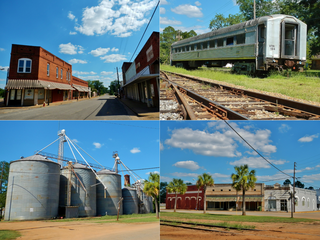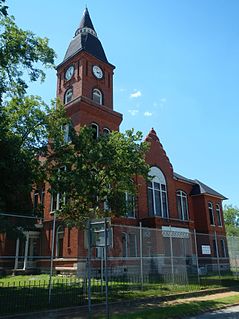
This is intended to be a complete list of the properties and districts on the National Register of Historic Places in Fairfield County, Connecticut, United States. The locations of National Register properties and districts for which the latitude and longitude coordinates are included below, may be seen in an online map.

The Williams–Woodland Park Local Historic District was established in 1985 and is a national historic district located at Fort Wayne, Indiana. The district encompasses 287 contributing buildings in a predominantly residential section of Fort Wayne located approximately one mile south of downtown. The area was developed from about 1875 to 1940, and includes notable examples of Colonial Revival, Prairie School, and Queen Anne style residential architecture.

The De Tonti Square Historic District is a historic district in the city of Mobile, Alabama, United States. It was placed on the National Register of Historic Places on February 7, 1972. It is a nine-block area, roughly bounded by Adams, St. Anthony, Claiborne, and Conception Streets. The district covers 28 acres (0.11 km2) and contains 66 contributing buildings. It was named in honor of Henri de Tonti and consists mainly of townhouses built between 1840 and 1860. It includes numerous examples of the Federal, Greek Revival, and Italianate architectural styles.

Virginville is a census-designated place in Richmond Township, Berks County, Pennsylvania. It is located at the junction of PA 143 and Crystal Ridge Road, and is approximately 7 miles to the south of the borough of Lenhartsville. As of the 2010 census, the population was 309 residents. Maiden Creek runs through the town and it also meets up with Sacony Creek.

Forest Hills Historic District is a national historic district located at Indianapolis, Indiana. It encompasses 173 contributing buildings and 7 contributing structures in a planned residential section of Indianapolis. It developed between about 1911 and 1935, and includes representative examples of Tudor Revival and English Cottage style architecture.

The Downtown Norwich Historic District is a historic district representing the core of the downtown area of the city of Norwich, Connecticut in the United States. It was listed on the National Register of Historic Places in 1985. It includes 115 contributing buildings and one other contributing structure over a 64-acre (26 ha) area. Several buildings in the historic district are also individually listed on the National Register, including the Norwich Town Hall, the Telephone Exchange Building and the Carroll Building.

The Millionaire's Row Historic District is a national historic district located at Williamsport, Pennsylvania. The district includes 263 contributing buildings and one contributing site in a residential area of Williamsport. The buildings date as early as 1855, and are representative of Victorian style architecture. Notable non-residential buildings include the Trinity Church and Parish House, First Church of Christ-Scientist, Weightman Block, Park Home, and the Covenant Central Presbyterian Church. Way's Garden is the contributing site and it was established in 1913. Located in the district and separately listed is the Peter Herdic House.
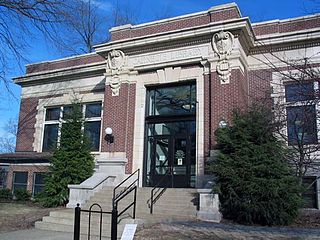
The Bayard Park Neighborhood is a neighborhood in Evansville, Indiana which is bounded by Lincoln Avenue, US Highway 41, Washington Avenue and Garvin Street. The Bayard Park Historic District contains approximately 87 acres including 335 contributing buildings and 1 contributing site within the neighborhood boundaries. It was added to the National Register of Historic Places in 1985. The architecture of residential homes in the neighborhood include quaint 1890s Queen Anne cottages, ground-hugging bungalows, American Fourquares, and high-style Early American and English revival types. The neighborhood also features Evansville's first neighborhood park and the East Branch Library, a Carnegie Library funded by the renowned philanthropist Andrew Carnegie.

Battle Ground Historic District is a national historic district located at Battle Ground, Tippecanoe County, Indiana. The district encompasses 129 contributing buildings in the central business district of Battle Ground, including the site of the Battle of Tippecanoe. It developed between about 1811 and 1930 and includes representative examples of Queen Anne, Colonial Revival, and Bungalow / American Craftsman style architecture. Notable contributing resources include the Soldier's Memorial (1908), Carpenter Hall / Service Center, Chapel, Winans House, Battle Ground United Methodist Church (1920), Masonic Lodge, Odd Fellow Lodge (1899), and Knights of Pythias Lodge (1899).

Cumberland Historic District is a national historic district located at Cumberland, Indiana. It encompasses 91 contributing buildings in the Cumberland section of Indianapolis. The district developed between about 1831 and 1950, and includes representative examples of Folk Victorian and Bungalow / American Craftsman style architecture. Notable contributing resources include the Cumberland Bank (1907), Masonic Lodge, Miller's Lunch, and First Baptist Church (1912-1913).

North Meridian Street Historic District is a national historic district located at Indianapolis, Indiana. It encompasses 169 contributing buildings in a high style residential section of Indianapolis. The district developed between about 1900 and 1936, and includes representative examples of Tudor Revival, Colonial Revival, and Classical Revival style architecture. Located in the district is the separately listed William N. Thompson House. Other notable contributing resources include the Evan-Blankenbaker House (1901), Sears-Townsend House (1930), MacGill-Wemmer House, Hugh Love House (1930), Hare-Tarkington House (1911), Shea House (1922), and Brant-Weinhardt House (1932).

Laurel and Prospect District is a national historic district located at Indianapolis, Indiana. The district encompasses three contributing buildings in the Fountain Square Commercial Areas of Indianapolis. It developed between about 1871 and 1932, and notable buildings include the Mangold / Roepke Saloon and Buddenbaum Grocery (1879).

Flanner House Homes is a national historic district located at Indianapolis, Indiana. The district encompasses 180 contributing buildings in the Project Area "A" of Indianapolis. It was developed between about 1950 and 1959, and include single family and duplex dwellings for African-American families. Notable buildings include the Revival Temple Church.

Ransom Place Historic District is a national historic district located at Indianapolis, Indiana. The district encompasses 74 contributing buildings in a historically African-American residential section of Indianapolis. It was developed between about 1890 and 1942, and include representative examples of Queen Anne style architecture. Notable buildings include the Light of the World Christian Church (1910).
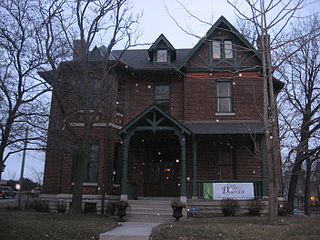
St. Joseph Neighborhood Historic District is a national historic district located at Indianapolis, Indiana. The district encompasses 57 contributing buildings in a predominantly residential section of Indianapolis. It was developed between about 1855 and 1930, and include representative examples of Italianate and Queen Anne style architecture. Located in the district are the separately listed Bals-Wocher House, William Buschmann Block, Delaware Court, Pearson Terrace, and The Spink. Other notable buildings include the Christian Place complex, Fishback-Vonnegut-New House, Henry Hilker House, Apollo-Aurora Rowhouses, Israel Traub Store, and Lorenzo Moody House.

Shortridge–Meridian Street Apartments Historic District is a national historic district located at Indianapolis, Indiana. The district encompasses 136 contributing buildings in a predominantly residential section of Indianapolis. It was developed between about 1900 and 1951, and includes representative examples of Colonial Revival, Classical Revival, Late Gothic Revival, Mission Revival, Renaissance Revival, Bungalow / American Craftsman, and Art Deco style architecture. Located in the district is the separately listed Shortridge High School. Other notable buildings include the Vernon Court Apartments (1928), Fronenac Apartments (1951), Biltmore Apartments (1927), Meridian Apartments (1929), New Yorker Apartments (1917), Howland Manor (1929), Powell-Evans House (1911), Harms House (1906), Dorchester Apartments (1921), and Martin Manor Apartments (1916).

Watson Park Historic District, also known as Watson Road Historic District and Watson McCord Neighborhood, is a national historic district located at Indianapolis, Indiana. The district encompasses 402 contributing buildings and 4 contributing sites in a predominantly residential section of Indianapolis. They include 255 houses, 27 multiple family dwellings, and 120 garages. It was developed between about 1910 and 1960, and includes representative examples of Colonial Revival, Tudor Revival, and Bungalow / American Craftsman style architecture. Located in the district is the Watson Park Bird Sanctuary.

The Maysville Historic District in Maysville, Georgia is a 170 acres (69 ha) historic district which was listed on the National Register of Historic Places in 1985.
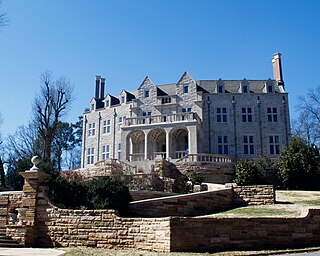
The Red Mountain Suburbs Historic District, in Jefferson County, Alabama, including parts of Birmingham and Mountain Brook, is a 333 acres (135 ha) historic district which was listed on the National Register of Historic Places in 1985. The listing included 392 contributing buildings and three contributing structures.

The Lewistown Central Business Historic District is a 28 acres (11 ha) historic district in Lewistown, Montana which was listed on the National Register of Historic Places in 1985. The listing included 54 contributing buildings.

